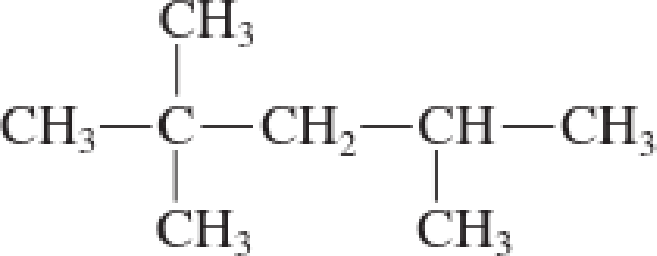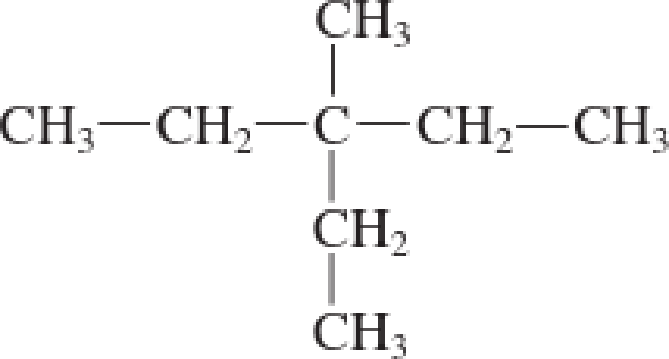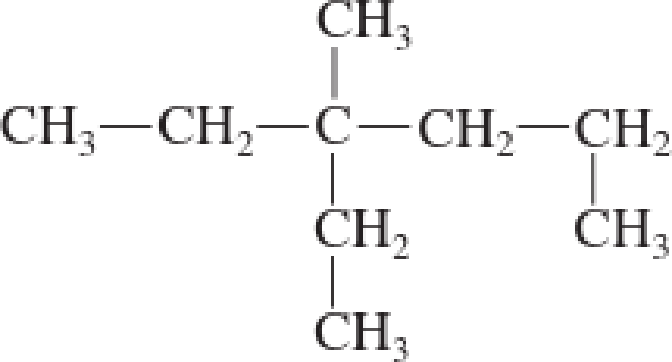
Bundle: General, Organic, and Biological Chemistry, 7th + OWLv2 Quick Prep for General Chemistry, 4 terms (24 months) Printed Access Card
7th Edition
ISBN: 9781305717534
Author: H. Stephen Stoker
Publisher: Cengage Learning
expand_more
expand_more
format_list_bulleted
Concept explainers
Textbook Question
Chapter 12, Problem 12.69EP
Convert each of the condensed structural formulas in Problem 12-51 to a line-angle structural formula.
a. 
b. 
c. 
d. 
Expert Solution & Answer
Trending nowThis is a popular solution!

Students have asked these similar questions
None
None
What spectral features allow you to differentiate the product from the starting material?
Use four separate paragraphs for each set of comparisons. You should have one paragraph each devoted to MS, HNMR, CNMR and IR.
2) For MS, the differing masses of molecular ions are a popular starting point. Including a unique fragmentation is important, too.
3) For HNMR, CNMR and IR state the peaks that are different and what makes them different (usually the presence or absence of certain groups). See if you can find two differences (in each set of IR, HNMR and CNMR spectra) due to the presence or absence of a functional group. Include peak locations. Alternatively, you can state a shift of a peak due to a change near a given functional group. Including peak locations for shifted peaks, as well as what these peaks are due to. Ideally, your focus should be on not just identifying the differences but explaining them in terms of functional group changes.
Chapter 12 Solutions
Bundle: General, Organic, and Biological Chemistry, 7th + OWLv2 Quick Prep for General Chemistry, 4 terms (24 months) Printed Access Card
Ch. 12.1 - Prob. 1QQCh. 12.1 - Prob. 2QQCh. 12.2 - Prob. 1QQCh. 12.2 - Prob. 2QQCh. 12.3 - Prob. 1QQCh. 12.3 - Prob. 2QQCh. 12.4 - Prob. 1QQCh. 12.4 - Prob. 2QQCh. 12.4 - Prob. 3QQCh. 12.5 - Prob. 1QQ
Ch. 12.5 - Prob. 2QQCh. 12.5 - Prob. 3QQCh. 12.6 - Prob. 1QQCh. 12.6 - Prob. 2QQCh. 12.6 - Prob. 3QQCh. 12.6 - Prob. 4QQCh. 12.7 - Prob. 1QQCh. 12.7 - Prob. 2QQCh. 12.8 - Prob. 1QQCh. 12.8 - Prob. 2QQCh. 12.8 - Prob. 3QQCh. 12.8 - Prob. 4QQCh. 12.8 - Prob. 5QQCh. 12.8 - Prob. 6QQCh. 12.8 - Prob. 7QQCh. 12.9 - Prob. 1QQCh. 12.9 - Prob. 2QQCh. 12.10 - Prob. 1QQCh. 12.10 - Prob. 2QQCh. 12.11 - Prob. 1QQCh. 12.11 - Prob. 2QQCh. 12.11 - Prob. 3QQCh. 12.12 - Prob. 1QQCh. 12.12 - Prob. 2QQCh. 12.12 - Prob. 3QQCh. 12.13 - Prob. 1QQCh. 12.13 - Prob. 2QQCh. 12.13 - Prob. 3QQCh. 12.14 - Prob. 1QQCh. 12.14 - Prob. 2QQCh. 12.14 - Prob. 3QQCh. 12.15 - Prob. 1QQCh. 12.15 - Prob. 2QQCh. 12.16 - Prob. 1QQCh. 12.16 - Prob. 2QQCh. 12.16 - Prob. 3QQCh. 12.17 - Prob. 1QQCh. 12.17 - Prob. 2QQCh. 12.17 - Prob. 3QQCh. 12.17 - Prob. 4QQCh. 12.18 - Prob. 1QQCh. 12.18 - Prob. 2QQCh. 12.18 - Prob. 3QQCh. 12.18 - Prob. 4QQCh. 12 - Prob. 12.1EPCh. 12 - Prob. 12.2EPCh. 12 - Prob. 12.3EPCh. 12 - Prob. 12.4EPCh. 12 - Indicate whether each of the following situations...Ch. 12 - Indicate whether each of the following situations...Ch. 12 - Prob. 12.7EPCh. 12 - Prob. 12.8EPCh. 12 - What is the difference between a saturated...Ch. 12 - Prob. 12.10EPCh. 12 - Prob. 12.11EPCh. 12 - Prob. 12.12EPCh. 12 - Prob. 12.13EPCh. 12 - Prob. 12.14EPCh. 12 - Prob. 12.15EPCh. 12 - Prob. 12.16EPCh. 12 - Prob. 12.17EPCh. 12 - Prob. 12.18EPCh. 12 - Convert the expanded structural formulas in...Ch. 12 - Prob. 12.20EPCh. 12 - Prob. 12.21EPCh. 12 - Prob. 12.22EPCh. 12 - Prob. 12.23EPCh. 12 - Prob. 12.24EPCh. 12 - Prob. 12.25EPCh. 12 - Prob. 12.26EPCh. 12 - Indicate whether each of the following would be...Ch. 12 - Indicate whether each of the following would be...Ch. 12 - Prob. 12.29EPCh. 12 - Prob. 12.30EPCh. 12 - Prob. 12.31EPCh. 12 - Prob. 12.32EPCh. 12 - Prob. 12.33EPCh. 12 - How many of the numerous seven-carbon alkane...Ch. 12 - Prob. 12.35EPCh. 12 - For each of the following pairs of structures,...Ch. 12 - Prob. 12.37EPCh. 12 - Prob. 12.38EPCh. 12 - Prob. 12.39EPCh. 12 - Prob. 12.40EPCh. 12 - Prob. 12.41EPCh. 12 - What is the name of the IUPAC prefix associated...Ch. 12 - What is the IUPAC name for each of the following...Ch. 12 - What is the IUPAC name for each of the following...Ch. 12 - Prob. 12.45EPCh. 12 - What is the chemical formula for each of the...Ch. 12 - Prob. 12.47EPCh. 12 - Prob. 12.48EPCh. 12 - Prob. 12.49EPCh. 12 - Prob. 12.50EPCh. 12 - Prob. 12.51EPCh. 12 - Prob. 12.52EPCh. 12 - Draw a condensed structural formula for each of...Ch. 12 - Draw a condensed structural formula for each of...Ch. 12 - Prob. 12.55EPCh. 12 - Prob. 12.56EPCh. 12 - Explain why the name given for each of the...Ch. 12 - Prob. 12.58EPCh. 12 - Indicate whether or not the two alkanes in each of...Ch. 12 - Prob. 12.60EPCh. 12 - How many of the 18 C8 alkane constitutional...Ch. 12 - Prob. 12.62EPCh. 12 - Prob. 12.63EPCh. 12 - Prob. 12.64EPCh. 12 - Prob. 12.65EPCh. 12 - Prob. 12.66EPCh. 12 - Do the line-angle structural formulas in each of...Ch. 12 - Do the line-angle structural formulas in each of...Ch. 12 - Convert each of the condensed structural formulas...Ch. 12 - Convert each of the condensed structural formulas...Ch. 12 - Assign an IUPAC name to each of the compounds in...Ch. 12 - Prob. 12.72EPCh. 12 - Prob. 12.73EPCh. 12 - Prob. 12.74EPCh. 12 - For each of the alkane structures in Problem...Ch. 12 - Prob. 12.76EPCh. 12 - Prob. 12.77EPCh. 12 - Prob. 12.78EPCh. 12 - Prob. 12.79EPCh. 12 - Prob. 12.80EPCh. 12 - Prob. 12.81EPCh. 12 - Prob. 12.82EPCh. 12 - Draw condensed structural formulas for the...Ch. 12 - Draw condensed structural formulas for the...Ch. 12 - To which carbon atoms in a hexane molecule can...Ch. 12 - Prob. 12.86EPCh. 12 - Prob. 12.87EPCh. 12 - Prob. 12.88EPCh. 12 - Prob. 12.89EPCh. 12 - Prob. 12.90EPCh. 12 - Prob. 12.91EPCh. 12 - Prob. 12.92EPCh. 12 - Prob. 12.93EPCh. 12 - Using the general formula for a cycloalkane,...Ch. 12 - Prob. 12.95EPCh. 12 - Prob. 12.96EPCh. 12 - Prob. 12.97EPCh. 12 - Prob. 12.98EPCh. 12 - How many secondary carbon atoms are present in...Ch. 12 - Prob. 12.100EPCh. 12 - Prob. 12.101EPCh. 12 - Assign an IUPAC name to each of the following...Ch. 12 - Prob. 12.103EPCh. 12 - What is wrong with each of the following attempts...Ch. 12 - Draw line-angle structural formulas for the...Ch. 12 - Draw line-angle structural formulas for the...Ch. 12 - Prob. 12.107EPCh. 12 - Prob. 12.108EPCh. 12 - Prob. 12.109EPCh. 12 - Prob. 12.110EPCh. 12 - Determine the number of constitutional isomers...Ch. 12 - Determine the number of constitutional isomers...Ch. 12 - Prob. 12.113EPCh. 12 - Determine whether cistrans isomerism is possible...Ch. 12 - Prob. 12.115EPCh. 12 - Prob. 12.116EPCh. 12 - Prob. 12.117EPCh. 12 - Indicate whether the members of each of the...Ch. 12 - Prob. 12.119EPCh. 12 - Prob. 12.120EPCh. 12 - Prob. 12.121EPCh. 12 - Prob. 12.122EPCh. 12 - Which member in each of the following pairs of...Ch. 12 - Prob. 12.124EPCh. 12 - Prob. 12.125EPCh. 12 - Prob. 12.126EPCh. 12 - Answer the following questions about the...Ch. 12 - Prob. 12.128EPCh. 12 - Prob. 12.129EPCh. 12 - Prob. 12.130EPCh. 12 - Prob. 12.131EPCh. 12 - Prob. 12.132EPCh. 12 - Prob. 12.133EPCh. 12 - Write structural formulas for all the possible...Ch. 12 - Assign an IUPAC name to each of the following...Ch. 12 - Assign an IUPAC name to each of the following...Ch. 12 - Prob. 12.137EPCh. 12 - Prob. 12.138EPCh. 12 - Prob. 12.139EPCh. 12 - Draw structural formulas for the following...Ch. 12 - Prob. 12.141EPCh. 12 - Prob. 12.142EPCh. 12 - Prob. 12.143EPCh. 12 - Prob. 12.144EPCh. 12 - Prob. 12.145EPCh. 12 - Prob. 12.146EPCh. 12 - Prob. 12.147EPCh. 12 - Prob. 12.148EP
Knowledge Booster
Learn more about
Need a deep-dive on the concept behind this application? Look no further. Learn more about this topic, chemistry and related others by exploring similar questions and additional content below.Similar questions
- Nonearrow_forwardNonearrow_forwardIn the solid state, oxalic acid occurs as a dihydrate with the formula H2C2O4 C+2H2O. Use this formula to calculate the formula weight of oxalic acid. Use the calculated formula weight and the number of moles (0.00504mol) of oxalic acid in each titrated unknown sample recorded in Table 6.4 to calculate the number of grams of pure oxalic acid dihydrate contained in each titrated unknown sample.arrow_forward
- 1. Consider a pair of elements with 2p and 4p valence orbitals (e.g., N and Se). Draw their (2p and 4p AO's) radial probability plots, and sketch their angular profiles. Then, consider these orbitals from the two atoms forming a homonuclear л-bond. Which element would have a stronger bond, and why? (4 points)arrow_forwardWrite the reaction and show the mechanism of the reaction. Include the mechanism for formation of the NO2+ 2. Explain, using resonance structures, why the meta isomer is formed. Draw possible resonance structures for ortho, meta and para.arrow_forwardNonearrow_forward
- 3. A molecular form of "dicarbon", C2, can be generated in gas phase. Its bond dissociation energy has been determined at 599 kJ/mol. Use molecular orbital theory to explain why energy of dissociation for C₂+ is 513 kJ/mol, and that for C2² is 818 kJ/mol. (10 points)arrow_forward9.73 g of lead(IV) chloride contains enough Cl- ions to make ____ g of magnesium chloride.arrow_forward6. a) C2's. Phosphorus pentafluoride PF5 belongs to D3h symmetry group. Draw the structure of the molecule, identify principal axis of rotation and perpendicular (4 points) b) assume that the principal axis of rotation is aligned with z axis, assign symmetry labels (such as a1, b2, etc.) to the following atomic orbitals of the P atom. (character table for this group is included in the Supplemental material). 3s 3pz (6 points) 3dz²arrow_forward
arrow_back_ios
SEE MORE QUESTIONS
arrow_forward_ios
Recommended textbooks for you
 Organic And Biological ChemistryChemistryISBN:9781305081079Author:STOKER, H. Stephen (howard Stephen)Publisher:Cengage Learning,
Organic And Biological ChemistryChemistryISBN:9781305081079Author:STOKER, H. Stephen (howard Stephen)Publisher:Cengage Learning, General, Organic, and Biological ChemistryChemistryISBN:9781285853918Author:H. Stephen StokerPublisher:Cengage Learning
General, Organic, and Biological ChemistryChemistryISBN:9781285853918Author:H. Stephen StokerPublisher:Cengage Learning
 Chemistry: The Molecular ScienceChemistryISBN:9781285199047Author:John W. Moore, Conrad L. StanitskiPublisher:Cengage Learning
Chemistry: The Molecular ScienceChemistryISBN:9781285199047Author:John W. Moore, Conrad L. StanitskiPublisher:Cengage Learning Introductory Chemistry: An Active Learning Approa...ChemistryISBN:9781305079250Author:Mark S. Cracolice, Ed PetersPublisher:Cengage Learning
Introductory Chemistry: An Active Learning Approa...ChemistryISBN:9781305079250Author:Mark S. Cracolice, Ed PetersPublisher:Cengage Learning ChemistryChemistryISBN:9781305957404Author:Steven S. Zumdahl, Susan A. Zumdahl, Donald J. DeCostePublisher:Cengage Learning
ChemistryChemistryISBN:9781305957404Author:Steven S. Zumdahl, Susan A. Zumdahl, Donald J. DeCostePublisher:Cengage Learning

Organic And Biological Chemistry
Chemistry
ISBN:9781305081079
Author:STOKER, H. Stephen (howard Stephen)
Publisher:Cengage Learning,

General, Organic, and Biological Chemistry
Chemistry
ISBN:9781285853918
Author:H. Stephen Stoker
Publisher:Cengage Learning


Chemistry: The Molecular Science
Chemistry
ISBN:9781285199047
Author:John W. Moore, Conrad L. Stanitski
Publisher:Cengage Learning

Introductory Chemistry: An Active Learning Approa...
Chemistry
ISBN:9781305079250
Author:Mark S. Cracolice, Ed Peters
Publisher:Cengage Learning

Chemistry
Chemistry
ISBN:9781305957404
Author:Steven S. Zumdahl, Susan A. Zumdahl, Donald J. DeCoste
Publisher:Cengage Learning
ENVIRONMENTAL POLLUTION; Author: 7activestudio;https://www.youtube.com/watch?v=oxtMFmDTv3Q;License: Standard YouTube License, CC-BY